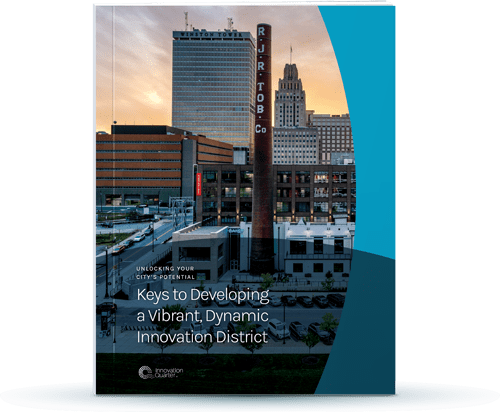Anchor institutions are named with intention—these prominent research universities, medical centers and cultural institutions are rooted in their cities and have the economic means to support themselves and often other aspects of their communities.
Many successful innovation districts lean into anchor institutions for ongoing collaboration by integrating them into the community’s core. Not only does this allow the institutions to develop their own competitive advantages, but it also enhances the quality of life within the community. The Brookings Institution has recognized such layouts as “anchor-plus” models. Positioned as a foundational pillar of an innovation district, anchor institutions can help drive long-term social and economic stability through their financial resources and role within inclusive innovation.
Anchor Institutions Bring Financial Support
Access to funds and physical assets is necessary when developing projects, but innovation districts require a significant amount given the broad and diverse range of activities and projects they encompass. Financing to that extent largely depends on anchor institutions’ financial assets and savviness. Universities typically possess significant real estate apart from their existing campuses, often nearby or in favorable locations, which can be transformed into a hub for innovative initiatives.
These spaces serve as a valuable physical asset for growing innovation districts, whether offsetting land acquisition costs or jumpstarting project initiations. In fact, the Global Institution on Innovation District’s (GIID) research cites Duke and Arizona universities as examples of institutions with prominent financial influence because of their perceived roles in stimulating the rebirth of downtown Durham and Phoenix.
The Role of Anchor Institutions in Developing Job Opportunities — and Talent to Fill Them
Job Creation
Anchor institutions are known for their power to help new businesses get on their feet, especially community-based, minority-owned or socially driven businesses. They advance the inclusive innovation that characterizes innovation districts by catalyzing job growth in underserved areas or for those with a lack of access to economic benefits that innovation affords. They partner with the community to develop initiatives that create living-wage jobs in low-income areas surrounding the institutions. These partnerships serve as a model for other minority-owned businesses that want to provide opportunities for citizens to earn an income while also strengthening ties within the community.
The Evergreen Cooperative Initiative seeks to provide living-wage jobs to low-income neighborhoods surrounding Case Western Reserve University and the Cleveland Clinic. The Evergreen Cooperative Laundry Initiative creates decent jobs that build wealth while addressing the needs of several of the area’s hospitals.
Talent Development
With new businesses and job creation comes a demand for talent, which anchor institutions are adept at delivering. Although the educational requirements for many industries continue to rise, there are growing opportunities in the life sciences and health sectors for those with associate degrees or less. This kind of access means informal learning opportunities and formal programming can broaden access to education and put members of disadvantaged and minority communities in route to well-paying, middle-skilled jobs, in addition to a first-class education. As documented by the GIID, anchor institutions can achieve this elevated access to education at all levels:
- Elementary, middle and high schools: To address disparities in the workforce, we’ve seen anchor institutions place a special focus around STEM (science, technology, engineering and math) programs for young women and minorities. For example, Phoenix has established a biomedical high school that sits on its biomedical campus and works with the local universities.
- Community colleges: Beyond that, community colleges have seen success through programs that combine the local public school system, a university and start-up companies within an innovation district to provide students with internships and a road to employment after graduation.
- Training cohorts: Outside of formal educational institutions, innovation districts can help improve unfilled or high-turnover job rates through training cohorts and customized programs catering to specific hiring needs of major companies in the district.




Anchor Institutions Bringing Stability and Growth to the Innovation Quarter
Anchor institutions are instrumental to the development and ongoing sustainability of innovation districts. Together, they create and distribute equal opportunities while positioning their communities at the cutting edge. At the Innovation Quarter, we strongly believe in the power behind educational partnerships and future implications for students, underserved communities and healthcare as a whole. From minority involvement in scientific research to developing Winston Salem’s entrepreneurial ecosystem, our anchor institutions are fundamental to staying at the forefront of health and science innovation.




